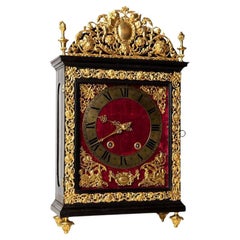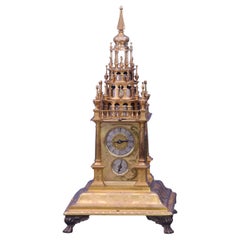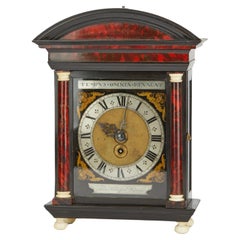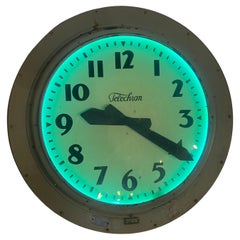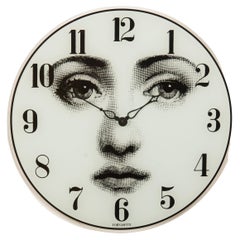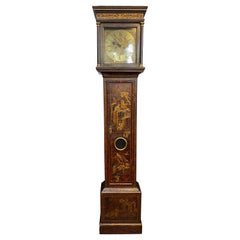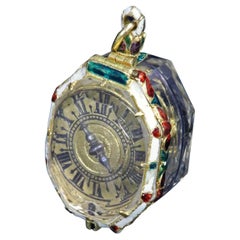17th Century Clocks
15
to
1
11
4
15
15
15
2
441
2,924
1,951
410
557
750
514
131
53
118
160
41
118
146
190
118
43
Height
to
Width
to
10
5
4
3
2
14
5
3
3
2
1
1
1
1
1
Period: 17th Century
Early French 'Pendule Religieuse' signed C Raillard
By Claude Raillard
Located in HAARLEM, NL
8-day movement, 2 spring barrels, verge escapement, thread suspended pendulum with cycloidal cheeks, striking full on the hours and one stroke on the half hours on a single bell, out...
Category
French Antique 17th Century Clocks
Materials
Brass
French late 17th century Louis XIV 'Religieuse Clock' by D. Champion of Paris
By D. Champion Paris
Located in HAARLEM, NL
Description
The tortoise shell case with lovely gilt mounts, the movement with verge escapment and cyclode arches, the attractive dial with chronos under the chaptering.
This love...
Category
French Antique 17th Century Clocks
Materials
Bronze
Rare c.1630 Augsburg Quarter-Striking Table Clock by Samuel Haug.
Located in Greenlawn, NY
Maker:
Samuel Haug, Augsburg. Germany.
Description:
An early 17th century gilt-copper quarter-striking table clock with alarm and adjustable striking by Samuel Haug of Augsburg.
...
Category
German Other Antique 17th Century Clocks
Materials
Bronze
17th-Century English Lantern Clock by Ignatius Huggeford
Located in Hoddesdon, GB
17th-century English , Lantern Clock, by the historically important London clock maker Ignatius Huggeford...
It is worth highlighting that Ignatius Huggeford held the distinction of...
Category
British Charles II Antique 17th Century Clocks
Materials
Brass
English bracket clock by Peter Garon
By Peter Garon
Located in HAARLEM, NL
An early English London signed black bracket clock with gilded ornaments and bun feet’s signed PETER GARON circa 1690. The handsome good looking clock with attractive dial with date ...
Category
English Antique 17th Century Clocks
Materials
Ebony
Hague clock by Tobias Klaaijssen Vlissinghe
Located in HAARLEM, NL
A tortoiseshell veneered Hague clock with elephant ivory mounted columns and ivory padfeet by Tobias Klaaijssen Vlissinghe. Completely checked and approved...
Category
Dutch Antique 17th Century Clocks
Materials
Ivory, Tortoise Shell
17th Century German Pocket Watch In 18k Gold
Located in Madrid, ES
17th Century German Pocket Watch In 18k Gold
ELEGANT POCKET WATCH WITH CASE AND SPHERE IN 18 K GOLD - IT HAS DIFFERENT MARKS - SEE CASE PICTURES. T...
Category
Antique 17th Century Clocks
Materials
Gold
17th Century Obelisk-Shaped Table Clock
Located in London, GB
17th Century obelisk-shaped table clock
Italian, 17th Century
Height 28cm, width 9cm, depth 7cm
A stunning piece from the 17th century, this table clock is a precious element of horological artistry and mechanical innovation. Encased in gilt and glass, the delicate clock is shaped akin to an obelisk, an intriguing symbol that lends a striking visual appeal.
The foundation of the timepiece is a gilt brass and...
Category
Italian Baroque Antique 17th Century Clocks
Materials
Brass, Ormolu
17th Century Regency Clock and Console Table
Located in Cantù, IT
A clock and console table in the style of Louis XIV made by parisian cabinet maker Lessure who specilised in the reproduction of statues of horses. He ...
Category
Italian Antique 17th Century Clocks
Materials
Brass
Cross-Shaped Chest Clock, Silver, 17th Century, it Presents Restorations
Located in Madrid, ES
Cross-shaped chest clock. Silver. 17th century. It presents restorations.
Portable clock in the shape of a cross with an openwork exterior showing Christian figurative scenes and the movement inside, a dial with a golden band with Roman numerals for the hours, a single needle and an engraved decoration around it, also with a religious theme; on the back, the back of the movement can be seen, with a delicate decoration, also openwork and based on plant motifs reminiscent of classicism, and a band on the case of the piece with simplified plant elements. Outside, we find ourselves on one side with Christ crucified, flanked by the Virgin Mary and Saint John, and the figures are surrounded by a delicate composition based on vegetable scrolls, with an angel's head at the foot of the piece. The other side shows the Resurrection of Jesus, with Christ emerging from the empty tomb...
Category
European Baroque Antique 17th Century Clocks
Materials
Metal, Silver, Other
William & Mary Floral Marquetry 8-Day Longcase Clock by LeCount 'LeCompte'
Located in Milford, NH
A fine and rare William & Mary long case or grandfather clock by London maker Daniel LeCompte. c.1690, London, the fine marquetry case having oval panels of birds and flowers, the movement signed Daniel LeCount (LeCompte) having a silver chapter ring and seconds dial, brass spandrels of cupids supporting a crown; including key, weights and pendulum. LeCompte was a French Huguenot...
Category
English Antique 17th Century Clocks
Materials
Brass
17th Century Antique Ebony and Gilt Table Clock by Edward Burgis of London
By Edward Burgis
Located in Devon, GB
A rare James II ebony and gilt-metal basket-top quarter-striking spring table clock. The latched 7 1/4 inch square dial has a matted centre, silvered and engraved chapter-ring with strike or silent above 'XII'.
The three-train verge fusee...
Category
British Jacobean Antique 17th Century Clocks
Materials
Ebony
Buschman “Minerva” German Horizontal Table Clock
Located in New Orleans, LA
The extraordinary beauty and superior craftsmanship of 17th century German clockmaking is on full display in this exceptionally rare horizontal tabletop timepiece dating to 1650 Augsburg. Created by Johannes Buschman the Younger, the eminent Buschman family of clockmakers are lauded for designing some of the finest timepieces to ever be created in the South German town of Augsburg during the late Renaissance and early Modern periods. A finely moulded ebony and turtleshell casing veneered in a mottled red hue holds the clock’s fusée and chain movement with verge escapement and balance with hogs-bristle regulation. A silver figure of Minerva, Roman goddess of war and wisdom, centers the Roman numeral-engraved chapter ring, indicating the time by pointing to the hour with an authoritative military staff as the sun rotates below her feet to indicate the minute. The incredible design is finished by a gilded backplate intricately pierced and engraved with a floral motif and the signature of Johannes Buschman.
Clocks are one of the greatest and most important inventions of the Renaissance period, improving steadily into the Age of Discovery. Embodying a renewed interest in science, the arts and humanism, the first mechanical timepieces began appearing in the 14th century and were large, weight-driven devices placed in the turrets of public buildings that struck the hour and lacked hands and faces. This clock was created during the first period of household clocks, when spring-driven movements made it possible to create smaller and more complex mechanisms. Such creations, however, were a luxury accessible only to the wealthy upper classes. Affluent patrons placed pressure upon artisans to create more elaborate and ornate clocks...
Category
German Renaissance Antique 17th Century Clocks
Materials
Silver
17th Century Walnut and Marquetry Longcase Clock
Located in East Hampton, NY
Late 17th century walnut and marquetry longcase clock. Marked "Windmills, London"
Category
English Antique 17th Century Clocks
17th Century Time Clock Cartel Louis XIV André Boulle Marquetry
By Gilles Martinot
Located in Marseille, FR
Pendulum cartel Louis XIV Boulle marquetry seventeenth and bronze Ormolu with its matching pedestal. baby decor mower by Martinot watchmaker in Paris. Good ...
Category
French Louis XIV Antique 17th Century Clocks
Materials
Marine turtle
Related Items
Rare OVERSIZED aRT Deco Neon Clock by Telechron Electric Clock.. 3' Diameter
Located in Buffalo, NY
Rare OVERSIZED aRT Deco Neon Clock by Telechron Electric Clock.. 34" Diameter.. Ive owned over 50 Neon Clocks,, very few this large,Tested and keeps perfect time,, Great color neon....
Category
American Art Deco Vintage 17th Century Clocks
Materials
Metal, Steel
Wall Clock by Piero Fornasetti
Located in Vienna, AT
Piero Fornasetti wall clock created in 1990s. Glass clock face with printed woman face and digits with quartz clockwork. Measures: Ø 37 cm.
Category
Italian Post-Modern 17th Century Clocks
Materials
Glass
English Silver & Tortoiseshell Carriage Clock in Form of Bracket Clock
Located in London, GB
A good English Edwardian silver and tortoiseshell hump backed carriage clock. With a French 8 day movement with lever escapement. Porcelain dial. Hallmarked for 1912 and with London ...
Category
English Vintage 17th Century Clocks
Materials
Silver
Victorian Mahogany Cased French Striking Mantel Clock
Located in Norwich, GB
Mahogany mantel clock in a break arch case with brass columns to either side, brass inlay to the front and surmounted by four brass finials.
Beautifully d...
Category
French Victorian Antique 17th Century Clocks
Materials
Mahogany
French 19th Century Louis XIV Style Figural Ormolu Clock Garniture, Raingo Frers
Located in Los Angeles, CA
A very fine and palatial French 19th century Louis XIV style figural ormolu three-piece clock and candelabra garniture suite, comprising of a gilt-bronze clock and a pair of ten-ligh...
Category
French Louis XIV Antique 17th Century Clocks
Materials
Bronze
H 34 in W 22 in D 13.5 in
Measured Time Clock by Isamu Noguchi
Located in Oklahoma City, OK
The Hawkeye Measure Time Clock Timer, a masterpiece by Isamu Noguchi, stands as a testament to both form and function. In impeccable working order, this timekeeping gem has undergone...
Category
American Mid-Century Modern Vintage 17th Century Clocks
Materials
Metal
Limited Edition Mid-Century Calendar Clock by Devon Clocks
Located in Amersham, GB
This unusual astrological calendar clock was designed by John Mercer Of Exeter, for the Devon Clock Company as part of the Heritage Collection. This example is numbered 31 of 500 and...
Category
English Mid-Century Modern Vintage 17th Century Clocks
Materials
Brass
Rare 1980s battery-operated world time table clock by Kienzle
Located in München, DE
Rare 1980s brass world time table clock by Kienzle.
Goes back to the design of Heinrich Johannes Möller. Made in Germany.
Kienzle is the oldest clock company in Germany.
Housing is m...
Category
German Regency Vintage 17th Century Clocks
Materials
Metal, Brass
Victorian Walnut Cased Striking Mantel Clock
Located in Norwich, GB
Late Victorian walnut break arch mantel clock standing on a raised plinth and resting on four outswept gilded paw feet and surmounted by four flame finials and a central finial.
H...
Category
German Victorian Antique 17th Century Clocks
Materials
Walnut
A Twin Fusee Bracket Clock By Dent
By Dent
Located in Amersham, GB
A striking two train bracket clock of exceptional quality by one of the great nineteenth century makers. The eight day twin fusee movement strikes on a blued steel gong behind a silvered arabic dial, signed Dent and numbered 58242 on both th dial and the back plate. Housed in a solid mahogany case with brass mounts and a gadrooned pergoda top surmounted by an acorn finial, and supported by bun feet. The sides ar pierced with attractive fish scale sound vents lined with dark blue velvet.
The movement and case are both of remarkable quality, as you would expect from a clock made by Dent. The history of Dent & Co. spans three centuries of precision watch and clock making in Great Britain. Established in 1814 by Edward J. Dent, the company embraced the Victorian fervour for technological innovation and created precision chronometers to navigate the Royal Navy and guide some of the most intrepid explorers on their voyages. The British Empire was in full expansion and its maritime tradition had produced some remarkable technological breakthroughs from the late 18th century. Propelling the impetus of Britain’s primacy, Dent proved a key player in Victorian horological history manufacturing the Standard Clock at the Royal Observatory, Greenwich which was to keep “Greenwich Mean Time” the time to which all others in the Empire were referred (better known today as G.M.T.) and continued to do so until replaced by an electronic clock in 1946. Dent also made probably the most famous clock in the world - the Great Clock for the Houses of Parliament, familiarly known as Big Ben.
Dent’s reputation soared and their chronometers accompanied some of the century's most influential and colourful explorers. Dent chronometer...
Category
English High Victorian Antique 17th Century Clocks
Materials
Brass, Steel
Edwardian Mahogany Inlaid Mantel Clock, Samuel Marti, Paris
By Samuel Marti
Located in Norwich, GB
Edwardian Mahogany Inlaid Mantel Clock
Edwardian mantel clock housed in a break arch mahogany case with walnut panels and satinwood line stringing , brass pillars to either side wit...
Category
French Antique 17th Century Clocks
Materials
Mahogany
Limited Edition Mid-Century Orrery Clock by Devon Clocks
Located in Amersham, GB
This unusual astronomical clock was designed by John Mercer Of Exeter, for the Devon Clock Company as part of the Heritage Collection.
The movement with going barrel and platform le...
Category
English Mid-Century Modern 17th Century Clocks
Materials
Brass, Steel
Previously Available Items
18th Century George I Style Lacquered Chinoiserie Grandfather Clock Longcase
Located in Roma, RM
Fantastic late 17th century English clock, black and red lacquered, with gold chinoiserie figures, mechanism untested but in good order. Small flaws, but a watch over 300 years old can...
Category
English George II Antique 17th Century Clocks
Materials
Wood
H 85.83 in W 17.72 in D 9.85 in
c.1630 English Enamel and Rock Crystal Pendant Watch
Located in Greenlawn, NY
Maker:
John Stileman, Londini
Case:
The back and front in faceted rock crystal with gold bezels are decorated with translucent red, green and white enamel. The pendant and but...
Category
English Antique 17th Century Clocks
Materials
Rock Crystal, Gold, Bronze, Enamel
18th Century George III Inlaid Mahogany Banjo Barometer
Located in Suffolk, GB
Antique 18th century George III inlaid mahogany banjo barometer having a swan neck pediment with original brass finial, original thermometer and an engraved silvered dial with origin...
Category
English Antique 17th Century Clocks
Materials
Mahogany
17th Century Oak Longcase Clock
Located in Martlesham, GB
A very rare late 17th century 24 hour oak cased striking longcase clock by the prominent maker Thomas White of Fairford. The cross plated movement has been sympathetically restored and is guaranteed in good working order, the brass dial is in aged condition with a single hand (dial can be restored if required) The oak case has been sympathetically restored retaining a lot of the original features.
Thomas White was a prominent clockmaker and records show was apprenticed to Thomas Tompion...
Category
British Antique 17th Century Clocks
Materials
Oak
German Renaissance Turret Clock
Located in New Orleans, LA
This immensely rare Renaissance turret-form clock, or the table clock, was considered both a scientific marvel and an item of luxury during the period. This incredible piece is encased in fire gilt brass crafted to resemble the giant striking clocks set within the turrets of buildings in the center of town. The mechanism strikes on the hour and quarter hour with an alarm feature. The movement is a gut/fuseé for going and striking train, a barrel for the alarm, a verge escapement and a foliot with a hog's bristle regulator complete with one hammer and one bell.
Clocks are one of the greatest and most important inventions of the Renaissance period, embodying the renewed interest in science, the arts and man's place in the world. The first mechanical devices that indicated time began appearing in the 14th century and were large, weight-driven devices placed in the turrets of public buildings that struck the hour and lacked hands and faces. This clock was created during the first period of household clocks when spring-driven movements made it possible to create smaller and more complex mechanisms. Such creations, however, were a luxury accessible only to the upper class. These patrons placed pressure upon artisans to create more elaborate and more beautiful clocks, of which this particular timepiece can be counted.
Renaissance clocks are an incredible rarity on the market, with most of the few known examples in the coveted collections of major museums throughout the world. Turret clocks...
Category
German Renaissance Antique 17th Century Clocks
Materials
Brass
English Chinoiserie Black Lacquered Tall Case Clock, Maker J. Jackeman, C. 1680
Located in Hollywood, SC
English chinoiserie black lacquered and gilt stenciled tall case clock with a steel numeral engraved face surrounded by flanking che...
Category
English Chinoiserie Antique 17th Century Clocks
Materials
Gold, Brass, Steel, Ormolu
H 76.5 in W 18.25 in D 10 in
French Equatorial Sundial by Butterfield
Located in New Orleans, LA
The ultimate 17th century traveler's companion, this rare and exquisite equatorial sundial by Michael Butterfield (1635-1724) is one of the first reliable and portable methods of telling time. The silver oval-form plate is meticulously engraved with indicators of the hours for specific latitudes of 42, 46, 49 and 52 degrees, which are divided in 15-degree increments that account for the rotation of the earth during a 24-hour period. In order to operate the sundial, the user must position the plate at a parallel angle that equals the local latitude. The gnomon, or pointer, must be pointed toward true north in order to give accurate time. Butterfield sundials are known for their hinged, adjustable gnomons that feature a diminutive bird, as displayed in the present example.
The reverse of the sundial plate is engraved with the latitudes for various French and European locations, which makes using the sundial easier to manipulate. Butterfield sundials are known as "semi-universal" horizontal dials, meaning that it can be used at different latitudes, but not in the full range of 0 to 90 degrees. Though Butterfield was not the inventor of this type of dial, the precision of his workmanship and the tell-tale bird gnomon became synonymous with this type of sundial. To find an example in such pristine condition that was made by and signed by Butterfield is quite exceptional.
About Michael Butterfield
Michael Butterfield was a British clockmaker who moved to Paris in the early 1660s. His portable sundials...
Category
French Other Antique 17th Century Clocks
Materials
Silver
Early 17th Century Flemish Tall-Case Clock with Oak Case and Pewter Dial
Located in Miami, FL
A very beautiful and early Louis XIII tall-case clock whose movement includes a single weight chain fall with a 24-hour wind, with a pewter and brass dial with arabesque embellishmen...
Category
Belgian Baroque Antique 17th Century Clocks
Materials
Brass, Pewter
Renaissance Turret Clock, Early 17th Century
Located in New Orleans, LA
This immensely rare Renaissance turret-form clock, or the table clock, was considered both a scientific marvel and an item of luxury during the period. This incredible piece is encased in fire gilt brass crafted to resemble the giant striking clocks set within the turrets of buildings in the center of town. The mechanism strikes on the hour and quarter hour with an alarm feature. The movement is a gut/fuseé for going and striking train, a barrel for the alarm, a verge escapement and a foliot with a hog's bristle regulator complete with one hammer and one bell.
Clocks are one of the greatest and most important inventions of the Renaissance period, embodying the renewed interest in science, the arts and man's place in the world. The first mechanical devices that indicated time began appearing in the 14th century and were large, weight-driven devices placed in the turrets of public buildings that struck the hour and lacked hands and faces. This clock was created during the first period of household clocks when spring-driven movements made it possible to create smaller and more complex mechanisms. Such creations, however, were a luxury accessible only to the upper class. These patrons placed pressure upon artisans to create more elaborate and more beautiful clocks, of which this particular timepiece can be counted.
Renaissance clocks are an incredible rarity on the market, with the handful of known examples in the coveted collections of major museums throughout the world. Turret clocks...
Category
German Renaissance Antique 17th Century Clocks
Materials
Brass
German Hexagonal Table Clock
By Elias Weckherlin
Located in New Orleans, LA
Exceptional beauty and innovation are on display in this rare German Renaissance table clock. Undeniably, some of the finest clocks of the 17th century were produced in the South Ger...
Category
German Renaissance Antique 17th Century Clocks
Materials
Brass, Copper
17th Century French Oak Tall CaseClock with Brass Rooster and Faience Clock Face
Located in Carmel, CA
The oak case is heavily carved with edelweiss flowers, branches and berries. The enamel clock face is hand-painted and indicates the hours, minutes and quarter hour.
The clock face...
Category
French Other Antique 17th Century Clocks
Materials
Oak, Faience
H 90 in W 17 in D 12 in
Renaissance Turret Clock, Early 17th Century
Located in New Orleans, LA
This immensely rare Renaissance turret-form clock, or table clock, was considered both a scientific marvel and an item of luxury during the period. This incredible piece is encased in fire gilt brass crafted to resemble the giant striking clocks set within the turrets of buildings in the center of town. The mechanism strikes on the hour and quarter hour with an alarm feature. The movement is a gut/fuseé for going and striking train, a barrel for the alarm, a verge escapement and a foliot with a hog's bristle regulator complete with one Hammer and one bell.
Clocks are one of the greatest and most important inventions of the Renaissance period, embodying the renewed interest in science, the arts and man's place in the world. The first mechanical devices that indicated time began appearing in the 14th century and were large, weight-driven devices placed in the turrets of public buildings that struck the hour and lacked hands and faces. This clock was created during the first period of household clocks, when spring-driven movements made it possible to create smaller and more complex mechanisms. Such creations, however, were a luxury accessible only to the upper class. These patrons placed pressure upon artisans to create more elaborate and more beautiful clocks, of which this particular timepiece can be counted.
Renaissance clocks are an incredible rarity on the market, with the handful of known examples in the coveted collections of major museums throughout the world. Turret clocks...
Category
German Renaissance Antique 17th Century Clocks
Materials
Brass
Recently Viewed
View AllMore Ways To Browse
Painted French Case Clock
Antique Clocks And Timepieces
Woman Clock
Louis Xvi Figural
19th Century Louis Xvi Style Clock
Antique French Empire With Ormolu
Arabic Style Furniture
Clock Made In England
Grandfather Clock Hand Painted
Louis Xv Bronze Clock
French Painted Mantel Clock
Antique Longcase
Gilt Ormolu Plates
French Enamel Urns
Mantel Candelabra
Black Mantel Clock French
Antique Clock Sound
Ormolu Bow
